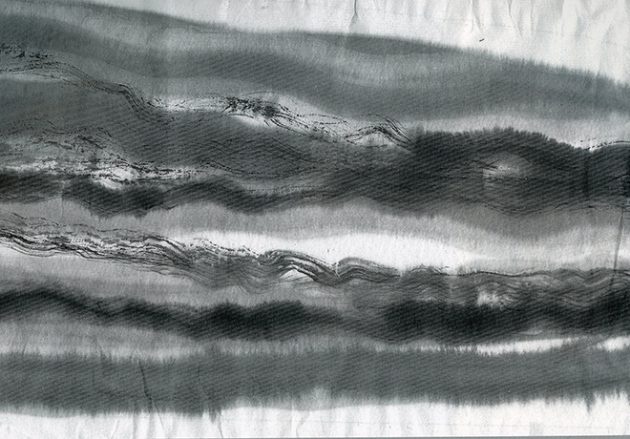

Sumi Workbook by Christine Flint Sato
[C]hristine Flint Sato’s Sumi Workbook presents a complete introductory course for amateur or professional artists who would like to try the traditional brushed ink arts of East Asia. Sumi, a black ink made of soot and animal glue, is the essential medium for the arts of calligraphy and ink painting, and, Sato warns, it is “essentially unpredictable.” Even professional sumi artists who have trained for years, do not expect complete control over their materials. So much depends on the thickness or dilution of the ink, the type of brush used, the quality and absorbency of the paper, and of course there is always an element of chance. You never know for sure what you are going to affect. Rather than being a source frustration, however, Sato tells us that this tension between chance and design is a source of endless fascination and “delight, as unexpected effects abound.” We are encouraged to think of the sumi artist’s concentrated response to this moment-by-moment unpredictability as a form of playful meditation, a liberating discipline.
Meditative playfulness and thoughtful experimentation are continually encouraged as the author takes us step-by-step through the process of learning the sumi arts. We are introduced to the practicalities: what the best materials are, where to find them, and how to hold your brush. “Don’t hunch over your work,” we are told, for attitude is also important: “Take a couple of breaths before you start, relax and smile!” And from the first brush-stroke a mindful focus is fostered: “Keep your mind on your breathing as you brush.” In a series of exercises we familiarize ourselves with the spring of the brush held in different positions and with different pressures and speeds. Gradually we learn to paint dots, then lines, and then essential shapes. Our teacher helps us to understand the psychological and emotional power of these abstract lines and shapes: a circle for calm completion, a triangle for energy, a square for balance. And when we have fully practiced these basic techniques, we learn to apply them to more complex designs and depictions.
Christine Flint Sato is uniquely qualified to bring the practice of these arts to a wider audience, having studied them herself over three decades and applied her knowledge in workshops she teaches in both Japan and the U.K. Having trained under Japanese master of calligraphy Seika Kawabe and Chinese ink painter Li Geng, she has an appreciation for the depth of tradition that lies behind these arts. Her book introduces the traditional models: the circle, square and triangle of Sengai’s “Universe”, the “Four Gentlemen” of bamboo, chrysanthemum, orchid and plum, and, for calligraphers, Chinese characters in both their modern and ancient forms. However, Sato doesn’t let her appreciation of tradition stifle her creativity: “Don’t worry about being ‘right,’” she says, “you are using the motif for your own ends.” In her own case, that end is exploring the boundaries of what is possible, for Sato also has a background in mixed media experimentation. In this book, too, she encourages the artist to move beyond tradition and try new things: crinkle the paper, splatter the ink, use a toothbrush or a feather instead of a brush!
The final chapter of the book presents a sampling of the author’s own artworks as a demonstration of the range of expression possible with sumi. Her art is of course beautiful in its own right. Christine Flint Sato has previously described her experience with sumi arts as her doorway into Japanese culture. In her innovative Sumi Workbook she opens a door for the adventurous beginner to follow her into the subtle arts of brushed black ink.

Michael Lambe is the author at deepkyoto.com